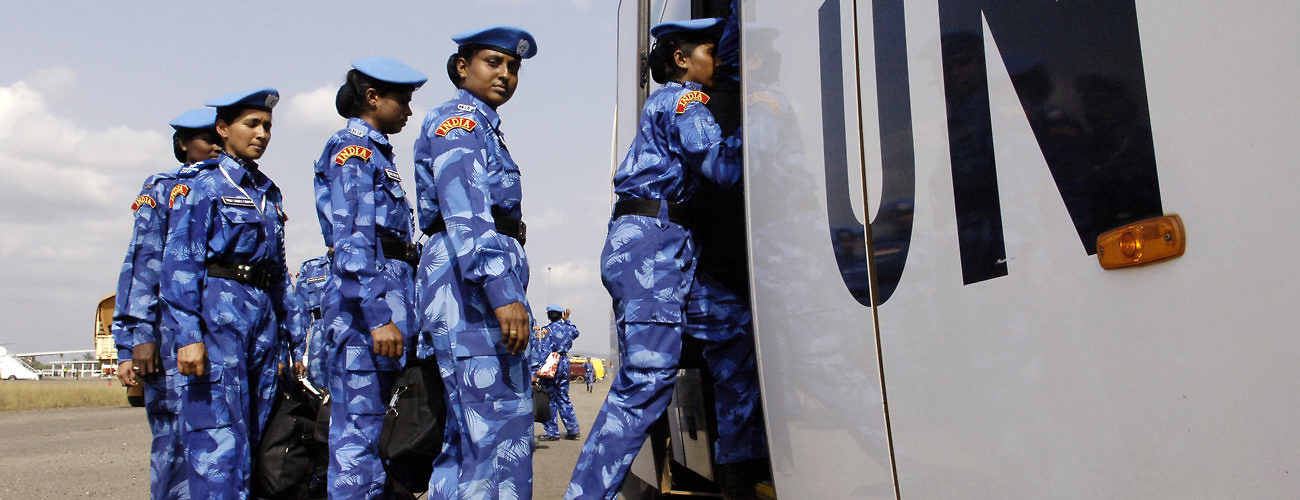Indian women peacekeepers arrive in Monrovia to serve in the UN Mission in Liberia. January 30, 2007. (Eric Kanalstein/UN Photo)
Next week, António Guterres will mark six months in what has been called “the most impossible job on earth,” the position of United Nations secretary-general. His tenure thus far has lived up to that billing: More than 20 million people are on the verge of famine, UN peacekeepers and investigators have been ambushed and killed in several missions, and the war in Syria grinds on, nearly half a million deaths later. Meanwhile, Guterres has sought with mixed success to build a relationship with Nikki Haley, United States President Donald Trump’s UN envoy, at a time of historic turbulence between the UN and its host and (for now) largest donor.
Upon arriving in Turtle Bay, Haley’s eyes turned quickly to reform of UN peacekeeping, its flagship and most costly enterprise. Although the president’s proposed budget recommends cutting more than $1 billion from the US peacekeeping bill, Haley claims she’s not interested in a “slash and burn” approach. She simply wants “better and smarter” missions. If so, one place that she and Guterres could find common cause is in increasing the number of women serving in UN peace operations.
Accumulating evidence demonstrates the unique role that women play in conflict prevention, peacekeeping, and peacebuilding. Not only can women perform the same roles as men, they can also deliver results that their male counterparts cannot. This is one conclusion from a recent Council on Foreign Relations discussion paper, How Women’s Participation in Conflict Prevention Advances U.S. Interests. To begin with, women peacekeepers help missions build stronger relationships with communities and gain more access to information than all-male contingents can deliver. They serve as role models, inspiring women in host countries to enter the security services themselves. Increasing the number of women in UN missions is also critical to ending a scourge of sexual exploitation and abuse by peacekeeping forces that causes tremendous suffering for its victims and diminishes the credibility UN peace operations globally.
Despite these advantages, women comprise a meager proportion of peacekeeping forces—less than 4% of soldiers and 10% of police deployed to UN missions. And the pace of change is achingly slow: 10 years ago the comparable figures were 2% and 6% respectively. Women make up a greater proportion of the UN’s deployed civilian staff, though, at 22%, they are still underrepresented, particularly at senior levels. The UN has repeatedly failed to meet its own pledges to achieve gender parity.
The issue came to the fore in last year’s race to become the next secretary-general, when candidates pledged to increase representation of women throughout the world body. Although the outcome disappointed those who had hoped for the first female secretary-general, Guterres himself won plaudits by quickly appointing three women to important positions, including Amina Mohammed of Nigeria as his deputy. Further, he pledged to appoint equal numbers of women and men to senior positions and committed to achieving gender parity in senior appointments by 2021. Work by the Center on International Cooperation suggests he is living up to his pledges. Guterres also issued a global call for nominations for candidates to lead peace operations, strongly encouraging member states to put forward women.
Of course, righting the gender imbalance will require more. To that end, Guterres appointed a gender parity task force, which is set to deliver its recommendations to the UN General Assembly this fall. And last week, the UN’s Department of Field Support (DFS) reopened the Senior Women Talent Pipeline, an initiative to identify and recruit qualified senior-level women to apply for director-level positions in missions and to build a larger pool of female leaders within the UN. Although currently limited to women with 15 or more years of experience, the next phase of the pipeline will expand to include midcareer women. When DFS first opened the pipeline in 2014, 3,000 women applied, 150 of whom were accepted.
Although these steps on the civilian side are important, the vast majority of peacekeepers are uniformed troops and police. And, on this score, the UN’s performance remains unimpressive. The small numbers of female peacekeepers is not simply a function of the low proportion of women in national armed forces. At last year’s peacekeeping ministerial in London, member states pledged to do better. Canada, which hosts this year’s ministerial in November, has included gender as one of the meeting’s focus areas, consistent with the new feminist foreign aid policy the nation has just unveiled.
Experience shows that targeted programs by major UN member states can make a difference. Since 2005, the US Global Peace Operations Initiative has trained more than 6,500 female peacekeepers from other countries, increasing the number of women that partner countries now deploy. To build momentum, the UN may want to create incentives for troop contributing countries, including offering a premium to those that provide female peacekeepers. To reach its full potential, however, any gender rebalancing must be accompanied by broader changes to the culture of UN peacekeeping (as detailed by Sabrina Karim and Kyle Beardsley in Equal Opportunity Peacekeeping), so that the women brought into missions have true power to effect changes on the ground.
Haley is right to demand better performance from UN peacekeeping. Several large-scale missions are in crisis, threatening to undermine faith in the entire enterprise. These shortcomings will not be helped by drastic cuts in the number of blue helmets deployed globally. If Haley is truly interested in “better and smarter” peacekeeping, the place to begin is by increasing the number of women serving in all roles in those missions.
Megan M. Roberts is Associate Director, International Institutions and Global Governance, at the Council on Foreign Relations (CFR). This article originally appeared on the CFR website.





